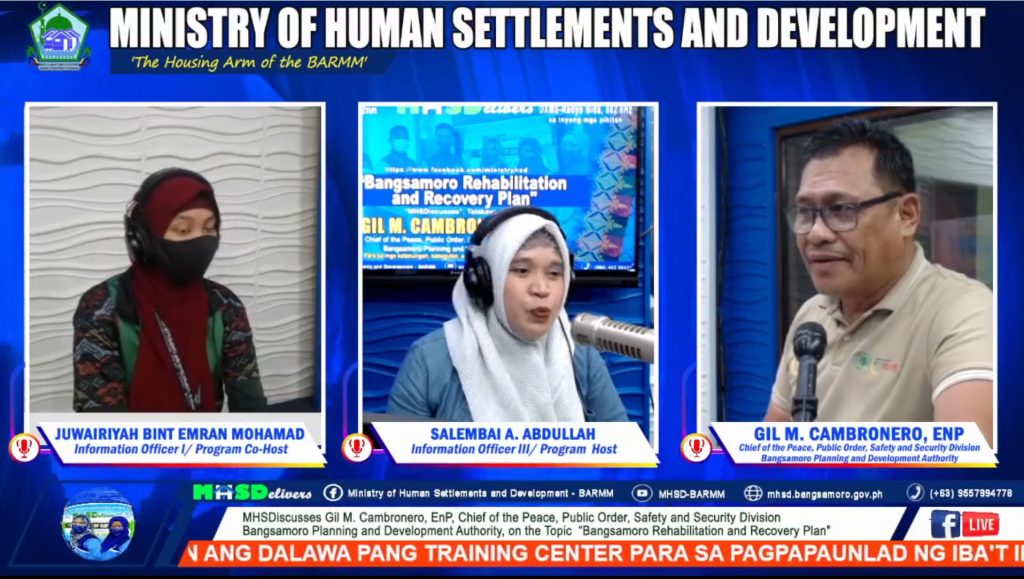
COTABATO CITY – The Bangsamoro Planning and Development Authority (BPDA) graced the Ministry of Human Settlements and Development’s (MHSD) radio program dubbed ‘Talakayan’ on Thursday, June 8, featuring the ‘Bangsamoro Rehabilitation and Recovery Plan 2023-2028 (BRRP 2023-2028) re: STS Paeng’ crafted for the affected communities in the BARMM.
Gil M. Cambronero, BPDA’s Chief of Peace, Public Order, Safety and Security Division (PPOSSD) and the focal person in the formulation of the said plan, served as a guest on the radio program aired via DXMS Radyo Bida in this city.
He underscored that the BPDA was involved in the formulation of BRRP, explaining that the BPDA is the led pillar of the Bangsamoro Disaster Risk Reduction and Management Council (BDRRMC) on rehabilitation and recovery. The other three (3) pillars are disaster prevention and mitigation led by the Ministry of Science and Technology (MOST), disaster preparedness led by the Ministry of the Interior and Local Government (MILG), and disaster response led by the Ministry of Social Services and Development (MSSD).
As the first rehabilitation and recovery plan for natural disasters formulated by the Bangsamoro government, the BRRP 2023-2028 will address the impact of Severe Tropical Storm (STS) Nalgae (locally named Paeng), the 16th tropical cyclone that entered the Philippine area of responsibility (PAR), brought heavy rains and strong winds to the Philippines which affected at least 4 million people as it traversed the landmass on October 28-31, 2022.
Cambronero stressed that the biggest concern to be addressed by the said plan is how to bring back the lives of the Bangsamoro, which is better than their former status in terms of education, access to basic services, economy, infrastructures, settlement, and effective governance in the pursuance of “Build Back Better Principle.”
He also called for the participation of all stakeholders to ensure that the implementation of the plan would generate a positive result by embracing the whole-of-government and whole-of-society approach. He added that the formulation of the said plan provides an avenue to strengthen BARMM’s partnerships with various stakeholders in providing programs and projects that would benefit its people, an opportunity to start conservation and preservation of the environment, strengthen interventions in disaster prevention, mitigation and preparation as means to combat natural disasters and increase the resiliency of Bangsamoro people during disasters.
According to the report of the National Disaster Risk Reduction and Management Council (NDRRMC), the severe tropical storm left at least 154 people dead (where 101 are confirmed and 53 for validation) and 35 missing, mainly due to flash floods and landslides. The Department of Social Welfare and Development (DSWD) reported that more than 200,000 families were displaced, and at least 73,000 families were evacuated to 2,938 evacuation centers. The cost of damage to agriculture is PhP2.86 billion, around 1,631 houses were destroyed, and 5,409 were partially damaged. A total of 164 local government units (LGUs) were declared under a state of calamity, including the BARMM.
Over 557,000 individuals in the Bangsamoro Autonomous Region in Muslim Mindanao (BARMM) were severely affected by the impact of STS Paeng. Regions 5, 6, 8, and 12 were also heavily hit by STS Paeng.
10 municipalities in the BARMM were severely hit by STS Paeng, namely: Datu Blah Sinsuat, Datu Odin Sinsuat, North Upi, Parang and Sultan Mastura in Maguindanao del Norte, Guindulungan in Maguindanao del Sur, Balabagan in Lanao del Sur, Maluso in Basilan, Indanan in Sulu and Bongao in Tawi-Tawi. Moreover, there are 47 areas or municipalities which are less affected are also included in the provision of interventions from BARMM ministries, offices, and agencies (MOAs) to address the impact of STS Paeng. (𝑀𝑎𝑟𝑦 𝐿𝑜𝑣𝑒𝑙𝑙𝑎 𝐿𝑎𝑜-𝐿𝑎𝑠𝑡𝑖𝑚𝑜𝑠𝑎 𝑤𝑖𝑡ℎ 𝑟𝑒𝑝𝑜𝑟𝑡𝑠 𝑓𝑟𝑜𝑚 𝑃𝑃𝑂𝑆𝑆𝐷, 𝐵𝑃𝐷𝐴-𝐵𝐴𝑅𝑀𝑀)



